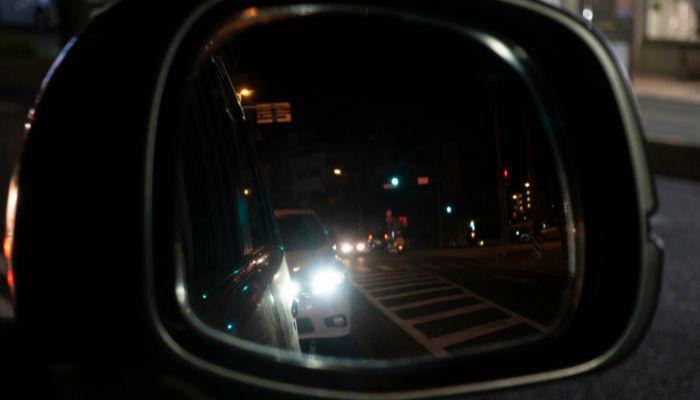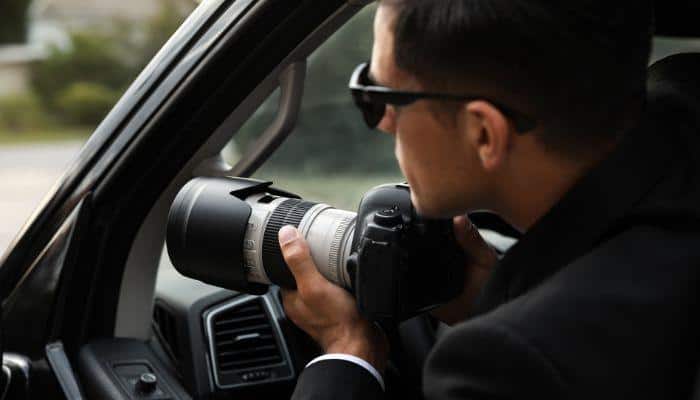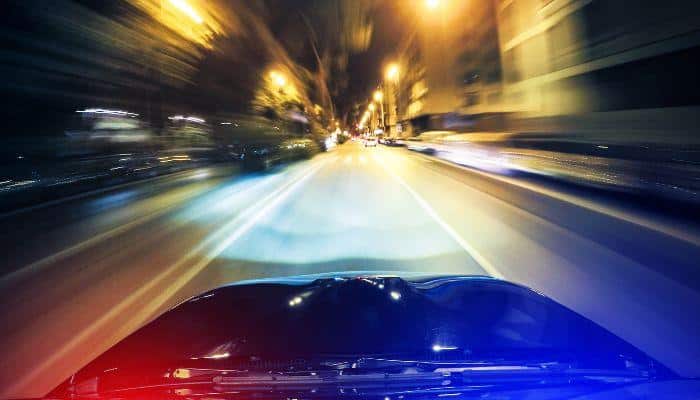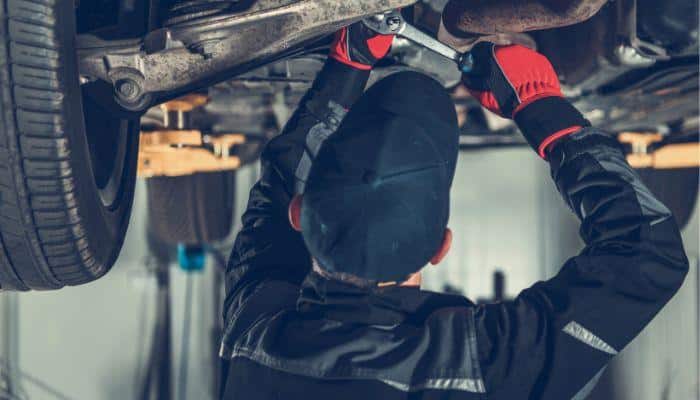Table of Contents
Think you might have a tail?
Or maybe you’re concerned you’ll have one in the future.
We’re going to school you in the art of counter-surveillance while driving so you can successfully identify, avoid and escape surveillance teams on the road.
How to Spot Surveillance While Driving

Being able to identify signs of surveillance while driving and conduct counter-surveillance in return is a skill-set you must learn. By developing an eye for suspicious activities and knowing what to look for, you can take proactive measures to counter potential threats.
Here are some key indicators to watch out for:
Persistent Tailgating
One of the common signs of surveillance is persistent tailgating by a vehicle behind you. If you notice a car that consistently follows closely and aggressively, even when there is ample space for them to maintain a safe distance, it could be a red flag.
This type of surveillance is known as targeted aggression and is overt in nature, it is used to provoke a response out of you or to make you think you’re in the clear once you’ve slipped that particular follow car. Be cautious of this kind of deception and don’t drop your guard.
Multiple Vehicle Changes
Another indication of potential surveillance is when you observe the same vehicles repeatedly changing and switching out in front of, or behind you. This involves different cars taking turns following you, which suggests a coordinated effort to monitor your movements.
If you suspect this is happening you must understand the adversaries you’re up against are highly motivated, funded and trained, typically only 3-Letter agencies or a foreign intelligence service are reliably capable of this.
Extreme counter-surveillance measures must be taken to thwart this kind of follow car system as they will have teams on adjacent side streets and much further ahead of and behind you constantly.
The higher the perceived threat you are, the more teams and follow cars will be in play until it comes to a point where detecting them is impossible and you never see the same vehicle twice.
Physical Cues

While driving, be observant of occupants in nearby vehicles engaging in suspicious communication methods, such as using handheld radios or hand signals. These covert methods could suggest coordination between vehicles.
Keep an eye out for cameras, parabolic microphones or binoculars too.
Depending on your threat level, you may encounter experienced teams that make no physical indication whatsoever.
Always note driver descriptions, license plates and any other distinguishing features of the vehicles in question for later analysis or recollection if you see them again.
Intentional Crossovers
If you notice a vehicle consistently crossing over to the same side of the road as you, especially when there is no apparent reason for them to do so, it may be a deliberate attempt to maintain proximity and monitor your activities.
Repetitive or Predictable Movements
They may exhibit repetitive or predictable movements as they try to keep track of your actions. Look for patterns such as vehicles repeatedly passing by your location or circling back in your vicinity.
These repetitive movements can be a sign that you are being watched and need to deploy counter-surveillance.
Evasion and Escape

At ToughPrey we urge you to drive safely and abide by traffic laws for your safety and the safety of others.
In high-stakes situations, being able to effectively escape pursuers while driving is critical. Whether you find yourself in a dangerous situation or need to evade surveillance, having the knowledge and techniques to outmaneuver your pursuers can make all the difference.
Varying Your Driving Patterns
An effective counter-surveillance technique to avoid detection, is to vary your driving patterns.
The same old predictable routines and routes will make it easier for potential surveillants to track your movements.
Instead try these:
Randomized Routes
Avoid taking the same routes repeatedly. They may anticipate your movements if you consistently use the same roads.
Use SDR’s and explore alternative paths to make it more challenging for them to predict your destination or better yet, never give them the intel on your intended destination to begin with.
Changing Departure and Arrival Times
If feasible, alter your departure and arrival times. They may be monitoring your activities during specific periods, so shifting your schedule is an effective counter-surveillance method and can disrupt their efforts.
This can help create uncertainty and make it harder for them to anticipate your movements.
Maintaining Situational Awareness
Always be aware of your surroundings when attempting to avoid surveillance while driving. Keep an eye out for vehicles that seem out of place or exhibit suspicious behavior, such as repeatedly appearing in your vicinity or making abrupt turns when you do.
High-Speed Driving Techniques
When faced with immediate danger or pursuit, employing high-speed counter-surveillance driving techniques can help create distance between you and your pursuers.
These require a combination of skill and precision, so it’s important to practice them in a controlled environment before attempting them in real-life situations.
- Acceleration and Speed Control: Utilize the full potential of your vehicle by accelerating suddenly and maintaining high speeds. This can make it challenging for pursuers to keep up while also making their attempts obvious. This buys you valuable time to create distance and plan your escape route.
- Evasive Maneuvers: Mastering these can help you navigate through traffic and throw off pursuers. Counter-surveillance techniques such as sharp turns, sudden lane changes, making intentional last-second turns without signaling, driving in loops or circles, U-turns, cutting someone off at the right time to put distance between you and the follow car and temporarily parking to observe if anyone follows you.
- Defensive Driving: This plays a vital role in maintaining control of your vehicle and avoiding collisions. Keep a safe distance from other vehicles and anticipate potential hazards. Use your mirrors frequently and scan your surroundings.
Utilizing Urban Environments

Cities and urban areas offer unique opportunities to elude pursuers due to their complex layouts and numerous escape routes. Understanding how to navigate through urban environments effectively can greatly increase your chances of escaping.
Consider the following strategies:
- Narrow Straights: Such as alleys or tunnels, let you leverage the advantage of maneuvering through narrow paths where larger vehicles may struggle to follow and smaller ones make their efforts obvious. These tight spaces can limit the mobility of pursuers, giving you the opportunity to escape or lose them in a maze-like urban landscape. Depending on the type of vehicle you own, this may not be a viable method.
- One-Way Streets: Being familiar with the road network, including one-way streets and dead ends, can work to your advantage. By strategically navigating through these areas, you can create obstacles for pursuers or force them into unfavorable choke-points, giving you an opportunity to escape.
- Blend into Traffic and Crowded Areas: In bustling urban environments, blending into traffic or crowded areas can make it harder for pursuers to single you out. By driving calmly and adopting the behavior of other drivers, you can become less conspicuous and decrease the chances of being identified or followed.
Minimizing Tracking Capability
It won’t matter if you’re able to successfully use counter-surveillance and escape or evade, if your car is bugged.
There are counter-surveillance tools and equipment available that detect tracking chips, audio/visual bugs or other covertly placed tech. You could also use RF signal jammers to prevent undiscovered bugs from working.
We recommend going the extra mile and getting tinted windows or privacy window films as a bonus.
Disable or Mask GPS Tracking
Most newer vehicles have built in GPS tracking capabilities with services like OnStar coming by default in most stock models. This can be used against you by your adversaries to act as a 24/7 beacon even when the vehicle is off.
For this reason, low tech older model cars are better, unless you’re mechanically savvy enough to manually disable this.
Additionally we highly recommend using an RF(Radio Frequency) signal jammer that covers a wide range of frequencies as sophisticated tracking tech will not always use standard frequencies to transmit, also consider using Faraday bags.
Visual Inspection
Start by visually inspecting your vehicle inside and out. Look for any suspicious or out-of-place objects, such as small devices attached to the undercarriage, wheel wells, or hidden compartments.
Pay attention to areas where a tracking device could be discreetly attached, such as near the fuel tank or underneath the dashboard, most devices will need a battery attachment so look for small cables leading to a separate power supply.
Use a flashlight to thoroughly examine the interior and exterior of your car, ensuring you don’t overlook any potential hiding spots.
Keep in mind advanced surveillance teams will place bugs that siphon power directly from the car battery, thus eliminating the need for a separate battery.
RF Bug Detectors
These are devices designed to detect the presence of electronic signals emitted by tracking devices.
These detectors are crucial to counter-surveillance and can help you identify hidden devices that may not be visible to the naked eye. When using an electronic bug detector, sweep it around your vehicle, focusing on areas where tracking devices are commonly placed, such as near the GPS antenna, wiring harnesses, or the OBD-II port.
Follow the manufacturer’s instructions for the specific bug detector you are using to ensure accurate results.
Vehicle Upgrades and Prepping

Ensuring the Car/Truck/Van or whatever you’re using is in optimal condition and properly equipped can make or break your ability to conduct vehicle based counter-surveillance. Regular maintenance and preparedness measures are essential.
Upgrading Security Features
Enhancing your vehicle’s security features can provide an extra layer of protection and deter potential pursuers. Install security systems such as interior alarms, immobilizers and hidden cameras to increase the difficulty of unauthorized access while teams are trying to plant bugs.
This is pro-active counter-surveillance and should not be relied upon completely.
Upgrading the Suspension
Reinforced shocks and suspension play a vital role in providing stability, control and responsiveness to your vehicle, particularly when driving on rough terrain or executing sudden maneuvers. These enhancements optimize the car’s handling capabilities, allowing for precise steering inputs and reducing body roll.
This increased stability translates to improved traction and grip, enabling you to maintain control and maneuverability when evading pursuers. Whether you need to make quick turns, execute sudden lane changes or navigate through tight spaces, these give you the upper hand in counter-surveillance chases.
Reinforced shocks also absorb and dampen the impact of road irregularities, minimizing vibrations and maximizing contact between the tires and the surface. This improves the vehicle’s ability to maintain traction during high-speed counter-surveillance maneuvers or evasive actions and reduces the risk of skidding or loss of control.
Regular Maintenance Checks
Regularly maintain and service your vehicle to keep it in reliable shape. This includes checking tire pressure, fluid levels, brakes and engine performance. A well maintained vehicle is more likely to perform at its best during high-stress situations.
If you read this thoroughly and implement some of these counter-surveillance techniques into your everyday driving when needed, you will undoubtedly have a better chance of successfully identifying, avoiding and escaping surveillance teams on the road.
You might also like:
Surveillance 101: Everything you Need to Know
Surveillance Detection Routes: The Most Effective Detection Strategy
Counter Surveillance Techniques on Foot: 4 Most Important Things to Check


